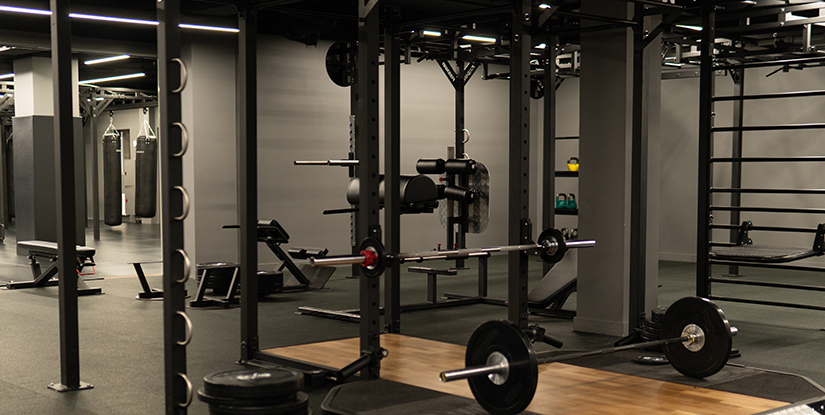When I first started looking into the types of squat racks for our gym setup, I honestly thought they were all pretty much the same. A rack’s a rack, right? Nope. There are way more types than I expected — and yeah, it matters more than I thought. Different builds, different features, and big differences in how they feel when you’re actually training. So I dug in, tried a few out, and figured out which type makes sense for serious use in a commercial gym. Here’s what I found.
Which Types of Squat Racks Fits Best?
After trying out all five types of squat racks — and doing way too much comparing — I realized each one really has its own vibe.
| Type of Rack | Key Features | Best For | Pros | Cons |
|---|---|---|---|---|
| Power Rack | 4-post cage, safeties, attachments | Full-body strength training in commercial gyms | Max stability, tons of options | Takes up space, higher price |
| Half Rack | 2-post, open front, spotter arms | Gyms with moderate space, solid lifting | Decent safety, more compact | Less safe under max loads |
| Squat Stand | Freestanding, minimal design | Basic barbell training, group sessions | Affordable, easy to move | Not ideal for fails or super heavy lifts |
| Folding Rack | Wall-mounted, folds flat | Space-saving commercial setups | Saves space, clean look | Lower rigidity, limited attachments |
| Combo Rack | Built-in bench and rack | Bench-focused programs | Compact, cost-effective | Limited exercises, not ideal for squats |
Power Rack — My First Serious Consideration
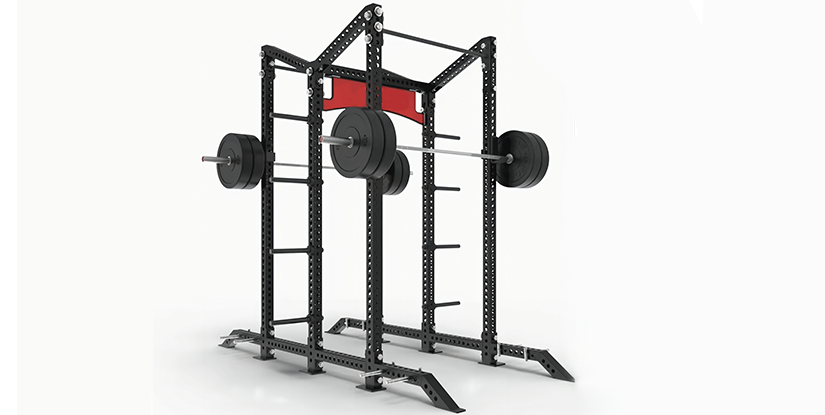
This was the first rack that actually made me stop and think, “Okay, this is legit gym gear.”
- What it is: A full-sized cage with four upright posts and built-in safety bars. It’s basically a mini training fortress.
- Key features: You’ve got height-adjustable safeties, J-hooks, plate storage pegs, and space for extras like dip handles or cable attachments.
- Pros/Cons: Super stable and crazy safe. You can fail a heavy squat and walk away fine. The downside? It’s massive and usually on the higher end price-wise.
- Who it’s for: Honestly, this is perfect for commercial gyms or serious lifters who want max versatility.
- Best for: Heavy squats, bench press, rack pulls, overhead pressing, and even stuff like rows or band work.
💡 Related: If you’re building glutes and using a full rack setup, check out Squat Rack Exercises for Glutes: 5 Moves That Actually Work — I found a couple favorites in there.
Half Rack — A Slimmer Option with Solid Support
After looking at power racks, I checked out half racks next. Honestly, they looked solid but way less bulky — which caught my eye.
- What it is: It’s like a power rack’s little brother — two upright posts instead of four, usually with spotter arms out front.
- Key features: You’ve got an open front for easy access, a smaller footprint, and some models still let you add pull-up bars or storage.
- Pros/Cons: Huge win for saving space. It’s still sturdy for most lifts, just not quite as bombproof as a full cage. If you’re pushing big numbers, make sure your form is on point.
- Who it’s for: Great for commercial gyms that don’t have endless square footage but still need something reliable for serious barbell work.
- Best for: Squats, benching, overhead pressing — just make sure your spotters are set right.
Squat Stand — Simple, Cheap, and Surprisingly Versatile
After messing around with full racks and half racks, I gave squat stands a shot. Didn’t expect much at first — but they actually held up pretty well.
- What it is: Just two upright posts. No cage, no frills — just what you need to rack a barbell.
- Key features: Adjustable J-hooks, easy to move around, simple setup.
- Pros/Cons: Way cheaper and lighter than other options. Super portable. But yeah… not the most stable under heavy weight. No safeties either, so not ideal for failed reps.
- Who it’s for: Works well for commercial setups like group training zones or for lifters who don’t need to max out every session.
- Best for: Back squats, front squats, overhead presses — just not ideal for failure-heavy sets.
🔧 Want to learn more about stand styles? Check out Independent Squat Stands vs Joined: Best Option for Small Spaces. That breakdown helped me figure out what setup worked best when space was tight.
Folding Rack — What I Almost Bought
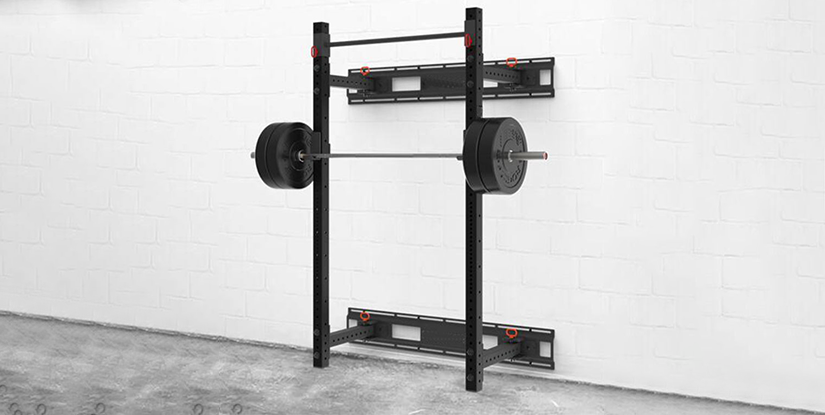
I’ll be honest — folding racks looked super slick when I first saw them. The space-saving design had me hooked at first.
- What it is: It’s a wall-mounted rack that folds out when I need it and folds flat when I’m done — perfect for saving space without ditching a real rack feel.
- Key features: Foldable arms, a pull-up bar across the top, and usually some J-hooks. Some even come with optional spotter arms.
- Pros/Cons: Big win for space. Looks tidy, especially in tight zones. But it can wobble under heavy loads and often lacks the full safety features you’d want in a high-traffic commercial gym.
- Who it’s for: Smaller commercial studios where space matters but you still want a pro-level feel.
- Best for: Basic squats, presses, and pull-ups — not ideal for maxing out or high-volume programs.
👉 I actually went deep comparing options — check out Folding Squat Rack vs Standard: What I Picked if you’re weighing this one.
Combo Rack — Bench + Rack in One
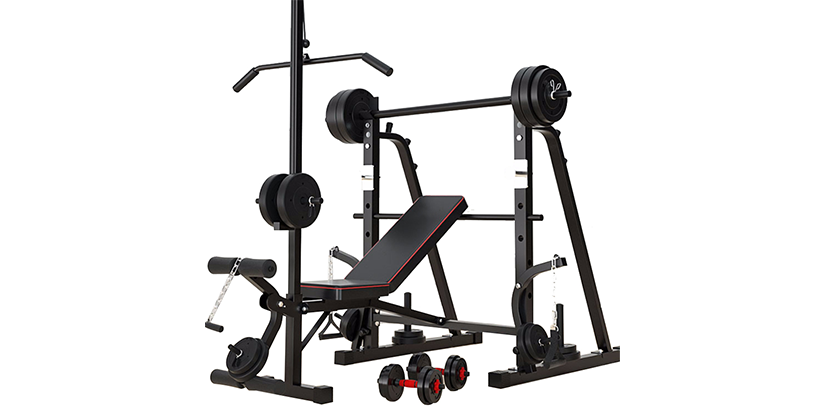
This was another setup I considered early on. It seemed clean, simple, and kinda budget-friendly. A lot of gyms still use them — especially if benching is the main event.
- What it is: Basically, it’s a flat bench that’s built right into a squat rack. No moving parts. Everything’s fixed in place.
- Key features: This one’s a bench press setup built right into the rack. So, you’ve got a fixed bench, barbell uprights right above, and sometimes adjustable uprights if you’re lucky. It’s made for benching first, squatting second — if at all.
- Pros/Cons: Alright, here’s the deal. It’s compact and doesn’t break the bank, which is great. Plus, you don’t need to move anything around to start pressing. But honestly, it’s not super flexible. You’re kinda locked into benching — squats feel awkward unless you’ve got just the right setup.
- Who it’s for: Good for gyms that focus more on upper-body work — think strength circuits or chest-focused programming.
- Best for: Flat bench press, incline variations (if adjustable), and maybe some light squats — if the rack height lines up right.
📌 Curious about this setup? I broke it down here: Olympic Weight Bench With Squat Rack: Worth It or Not?
If You Don’t Have a Rack, You Still Have Options
I’ve had days where I couldn’t get to a rack. Either it was taken or out of commission. Still wanted to train legs — so I got creative.
Turns out, you can get a killer session without one.
I still run through moves from Barbell Leg Exercises No Rack: 13 Moves I Use when I need variety or I’m working with limited setup.
Also, I used to wonder if squatting without a rack was just asking for trouble. But with the right setup? It’s doable.
I broke it all down in How to Squat Without a Rack Safely. If you’re short on equipment but still want to hit legs, that’s your go-to.
At first, I thought all types of squat racks were basically the same. But once I dug in, tried different setups, and actually trained with them — I realized the type of squat rack totally changes your experience.
Whether you’re running a full commercial gym or setting up a focused lifting space, picking the right types of squat racks makes training smoother, safer, and way more effective.
So yeah… it matters.
Now you know. Lift smart.
FAQs about Types of Squat Racks
Honestly, it depends on what you’re after — but for most commercial gyms, the power rack wins hands down. It’s rock-solid, full of features, and can handle everything from squats to heavy rack pulls. You get safety bars, tons of attachments, and no real weak points. Sure, it takes up more space and costs a bit more, but you’re getting serious bang for your buck. If you’re building a setup for heavy lifters or high-volume traffic, this is the one to bet on — no question.
So, squat bars aren’t all the same — here’s the quick breakdown:
Standard Olympic bar – your classic all-rounder.
Safety squat bar (SSB) – comfy pads, less stress on shoulders.
Buffalo bar – cambered design, easier on wrists.
Cambered bar – totally throws off your balance (on purpose).
Multi-grip bar – weird handles, more angles.
Each one hits different, so lifters usually rotate depending on the goals or injury needs.
Here’s the short of it: power racks are like the big brother of squat racks. A power rack is a full cage — four posts, safety bars, and serious support. A basic squat rack, on the other hand, might just be two uprights. Less steel, less safety. So, if you’re going heavy or care about versatility, a power rack’s the clear upgrade. But if space or budget’s tight, a simpler squat stand still gets the job done (with more focus on good form).
Powerlifting racks come in a few main flavors.
Power racks — full cages with safeties and accessories galore.
Combo racks — built for squat and bench meets, adjustable, and comp-approved.
Monolifts — you unrack the bar without stepping back (yeah, wild).
Half racks — more compact, but still pretty sturdy.
For official meets or elite gyms, combo racks and monolifts rule. But for training, power racks are still the workhorse — strong, safe, and super versatile.
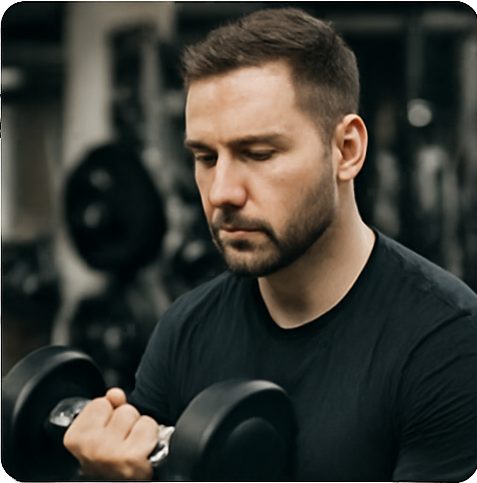
Hi, I’m the editor here at Leadman Fitness. We’re a manufacturer focused on producing top-quality barbells, plates, kettlebells, dumbbells, and strength training gear. I’ve been into sports and fitness for years, and I know my way around all kinds of gym equipment—both from using it and helping create it.
I spend a lot of time understanding the real problems people run into in the gym—whether it’s beginners trying to pick the right gear or experienced lifters looking for something more durable. I stay in close touch with our production team and talk directly with other equipment makers, so we’re always improving based on what real lifters and coaches are looking for.
What I share comes from hands-on experience—stuff that actually helps people train better, not just in theory, but in real gyms.
